"I was human once" begins a soliloquy from a successful alchemist who developed an elixir that gave him immortality and magical powers. What would you sacrifice for immortality and magical powers? We find that the price was quite high, and he wouldn't do it again if he had a choice. The lesson was learned, but it's too late to back out. You can't appreciate the value of time when it's unlimited, and all the power in the world doesn't help you in your relationships with other people if you are no longer human.
Cory Williams of Daydream Studios made this animation in just five days with the help of various modern animation tools, including Unreal Engine. You can see a behind the scenes video here. It will give you a new appreciation for the technology that puts such power in the hands of animators, and you will surely appreciate Williams' voice work. -via Laughing Squid

Imagine being a Jewish soldier in the Union Army during the Civil War, in what would later become West Virginia where no one knew how to celebrate Passover. There were 21 Jewish soldiers in the 23rd Ohio Volunteer Infantry Regiment under the command of future president Rutherford B. Hayes in 1862. Most were young men who had celebrated, but had never organized a Passover Seder before. Private Joseph A. Joel obtained permission for the soldiers to take a day off for the Seder, and it was granted.
The men had to enlist help from their provisions supplier and the local residents to get what they needed for the feast. Cider was a substitute for wine, and whatever they substituted for the usual horseradish and parsley as the bitter herb was so bitter that it caused the men to drink all the cider and the Seder got quite lively, or even rowdy. Joel published an account of that Seder in 1866 in the Jewish Messenger. While it wasn't the only Passover celebration on the battlefield, it was the one best documented for posterity, and you can read about it at Smithsonian.
Warning: this video contains lots of NSFW language. The Marvel Cinematic Universe is crossing its fingers that bringing back two of its more popular superheroes in the R-rated Deadpool & Wolverine will reverse its fortunes after a slew of disappointing movies with lesser-known comic book characters. Maybe a young teen audience isn't all that necessary when you've got sass, action, blood, humor, and two proven stars in Ryan Reynolds and Hugh Jackman. In this film, a disruption of the timeline is on the line, so to speak, so Deadpool and Wolverine must team up to set things right. The villain is Cassandra Nova, played by Emma Corrin, the evil twin sister of Charles Xavier. So, do Deadpool and Wolverine hate each other like it seems in this film, or is that just the way guy friends act sometimes? We will find out when Deadpool & Wolverine hits theaters on July 26.

There is this phrase which says, "History is written by the victors." For much of human history, that seems to have been the case. Whoever had the power to write history were the ones who made history. Whether or not that version of history includes all the gory details, can sometimes be put into question.
For the most part, we cross-reference certain events and anecdotes with other narratives describing the same events or the surrounding context of those events, in order for us to see the bigger picture, since there's always multiple perspectives in a historical event.
We started with this because there are many historical markers installed throughout the US. More than 180,000 markers recounting different stories of people and events in US history have been placed in various states. They are supposed to capture a moment in time and place, but it seems that some of them have history wrong. Moreover, several of them are quite offensive.
This NPR special series tackles the way that certain historical markers erected in different parts of the US are attempting to rewrite US history, as well as describing other people groups like Native Americans and African-Americans in a bad light.
Currently, the federal government, or even the state governments, aren't doing anything about it because there's just so many historical markers that to try and revise each one is going to be a herculean task, and nobody has enough energy and resources to put into it.
Another reason why so many markers have been placed is because it only cost a few thousand dollars to order one. Originally, these markers were created to motivate Americans to travel to different states and spur their interest in the different towns, cities, and sights that other places have to offer.
So, with the relative ease of putting up these historical markers, it's probably no surprise how the number of historical markers skyrocketed, and the fact that nobody is regulating them, is one of the reasons why there are markers with competing claims or just downright problematic.
To see several examples of such historical markers, you may check them out here. Furthermore, there is also an online database that keeps track of all the historical markers throughout the US. So far, they have counted more than 211,000 historical markers to date.
(Image credit: Everydaypsyche/Wikimedia Commons)

Okay, this sounds ridiculous. Who would be scared to driver over a bridge? Who would pay $40 to have someone else drive them across this bridge? I mean aside from the whole ship-crashing-into-bridge thing going on lately.
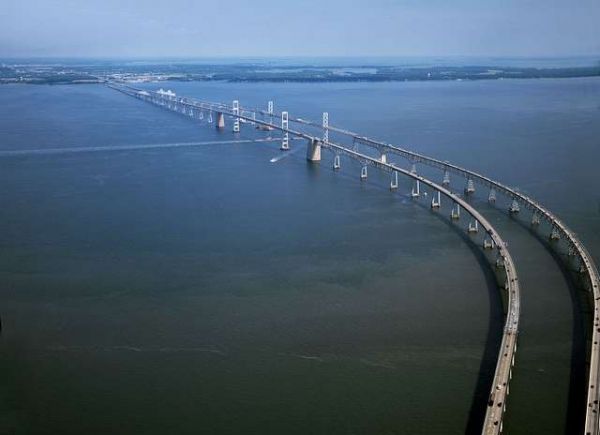
But maybe not. The bridge bisecting Chesapeake Bay is six and a half miles long and has two lanes of traffic each way with no shoulder. Some redditors say that it's actually hard to drive because the design of the bridge messes with the depth perception of some drivers.
The Washingtonian reports that the Kent Island Express company drives about 12-15 people per day. Many wear sleep masks to block the sight of the bridge and the disorienting effects that some people experience from seeing it. Since the bridge collapse in Baltimore, the business is up 10-15% due to riders who have only more reason to fear bridge crossings.
-via Chris Koerner | Photos: Kent Island Express, Library of Congress
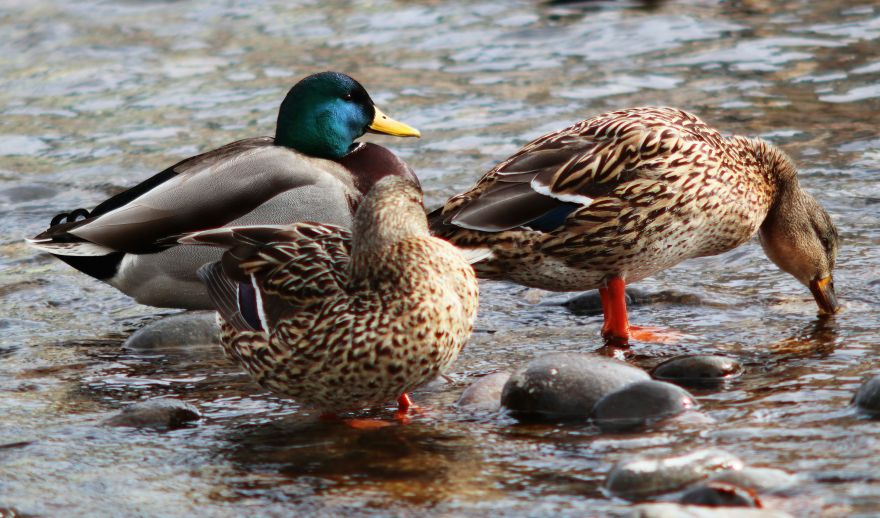
There's nothing more endearing than the symbiotic relationship developed between people and wildlife. As much as we benefit from the resources we take from nature, I think it's also our responsibility to take care of them. Although wildlife in their natural state rely on their own instincts to survive, human intervention can sometimes aid in the preservation of wildlife and to ensure that they can live and grow without too much threat on their lives or that of their young.
That is the kind of relationship that has been forged through centuries and generations of Norwegian tenders and the eiders, one of the largest sea birds in the arctic. Sort of a mix between a goose and a duck, the eiders have been under the care of bird-raising families since the 1600s.
The caretakers of these eiders have gained much knowledge and experience which they have passed down from one generation to the next in the hopes of keeping this mutual bond between the birds and humans alive. This story, covered by Devon Frederickson, gives us a sneak peek into the lives of the eiders and their caretakers who have grown to love them even as their own family.
For the most part, during brooding season, eiders huddle into their nests where they lay their young and keep them warm until they hatch after 25 to 28 days. After that time, the eiders leave the nest and what's left are the down feathers which the caretakers collect and gather to be used as raw materials in manufacturing duvets, jackets, coats, and other apparels.
In all the world, eiderdowns are the softest, which is why their scientific name, Somateria mollissima, is such because the Latin species name mollissimus translates to "the softest". But profit is not the primary motivation for these elderly caretakers, some of whom have been taking care of these ducks for half a century, their whole lives in fact. They do it because of the legacy of love passed on to them by their ancestors.
Eider numbers are currently dwindling. One factor is climate change, which can also affect another factor, the behavioral changes of wildlife within the ecosystem. This not only includes the eiders themselves, but also their source of food and the predators which are perhaps the biggest threat to eider numbers.
This is why the eider-human relationship is necessary, because eiders find shelter and peace in the presence of their human caretakers. They are able to breed in peace while the humans shoo away their predators. The eiders can find nesting grounds prepared by their caretakers, which makes life for the eiders easier.
They can tend to their young without the stress of having to defend them from outside interference. Although there are still instances when larger birds of prey would swoop down and take one of the ducklings from the group, which many of the caretakers find incredibly saddening, as they have already formed tight bonds with them. They consider each one already a part of their own family.
Over the past century, as many bird keepers moved into the industrial parts of Norway, only few remained to take care of the birds, and that caused their numbers to decrease drastically. From a population of about 7,000 nesting eiders in 1900, that number shrunk to only 400 nesting females by 2004.
And so now, there is a deep need to encourage more people to maintain this age-old tradition, not merely for their own profit or benefit, but mostly for the birds' future. People like Rita Johansen, Albert Stensholm, Vibeke Steinsholm, and Hildegunn Nordum, with whom Devon Frederickson corresponded to write this story, are only some of the growing number of people concerned about the eiders welfare and posterity.
Their goal is to bring the eiders' situation to national attention, and collaborate together with the government and other leading figures such as UNESCO to restore the once thriving eider population. To the bird keepers, this is more than just some hobby or business, it's their way of life. It's their history. It's their commitment and their place in the world.
(Image credit: Simon Hurry/Unsplash)
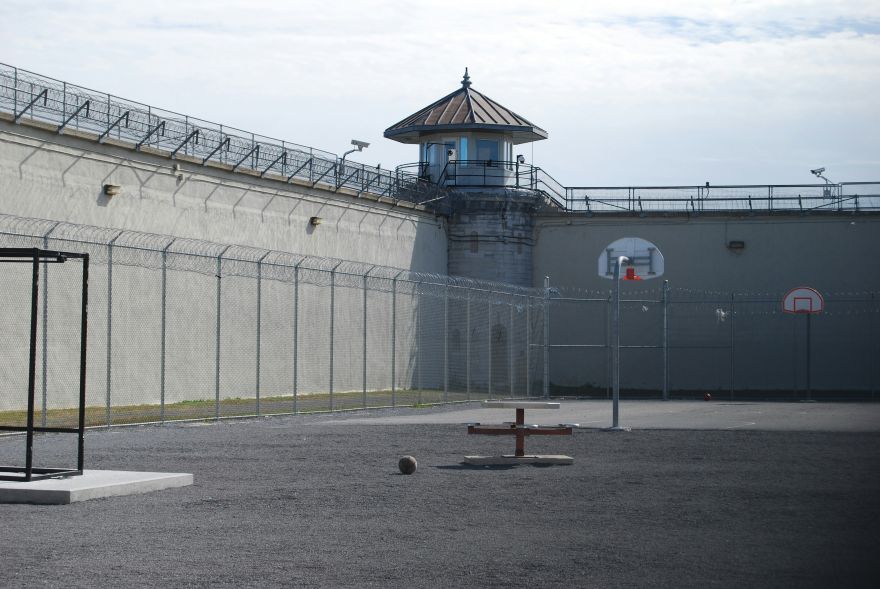
We often think of prisons to be the most inhumane places in society, because of what we see in media or what we hear from people who have been there. Or, perhaps from personal experience, whether we know someone who is or has been incarcerated, or have experienced being incarcerated ourselves. What usually comes to mind when we think of prisons is that it's a scary place, being a hub filled with offenders.
Of course, prison is partly a place to detain and isolate individuals from society so that they can be rehabilitated, if possible. Otherwise, they will be kept there for life if the courts deem them to pose a significant level of threat to society. But there are some prisons that have the weirdest rules, which can either be thought-provoking or just downright silly.
On this list compiled by Pauli Poisuo of Grunge, perhaps the most surprising prison policy is that of Bastoy Island in Norway. The prevailing rule in the prison is one of trust and respect. This can be seen from the fact that guards are unarmed, prisoners live in cabins with their own rooms, and they can even be cook their own food as well as be productive with their own jobs.
This defies the conventional notion that we have of prisons, that they are inhumane and inhospitable to its inhabitants. In fact, Bastoy has become a community in itself, like its own village. Not only that, prisoners also have the freedom to go fishing or even swim at the beach.
Perhaps, this first example would make us pause to think about how we think about the people who have committed crimes, why they did so, and how we should exact justice yet still enable them to maintain their humanity. We don't know, however, whether the prisoners here are just petty criminals or big-time offenders, committing heinous crimes. But the fact that even the guards are willing to go unarmed says much about the culture in Norway, and how they view individuals, the penal system, and justice.
Next to this, I would say that the second most humane policy is that of Aranjuez Prison in Spain. What they have implemented is something called the family cell program. That is, when both parents have been incarcerated, they allow children under the age of three to live with their parents inside the prison. And they're not living in squalid cells either. There's a special area fitted with amenities of a regular household.
This may not be the best solution, but experts agree that it is a preferable method than letting children grow up without their parents, especially during their formative years. Plus, the little children will also have playmates inside so it's not the worst environment.
This third one is the weirdest. It was a policy implemented by Maricopa County Sheriff Joe Arpaio, who has been dubbed "America's Toughest Sheriff". In response to increasing cases of undergarment theft in the prison, Arpaio launched the pink underwear campaign. Everything from undergarments, socks, blankets, and even handcuffs were in pink.
It didn't last long as the new sheriff abolished all the policies that his predecessor implemented. These are only some of the most unconventional prison policies in the world. There are several more on Grunge's list, and you might be intrigued by them as well.
(Image credit: Larry Farr/Unsplash)
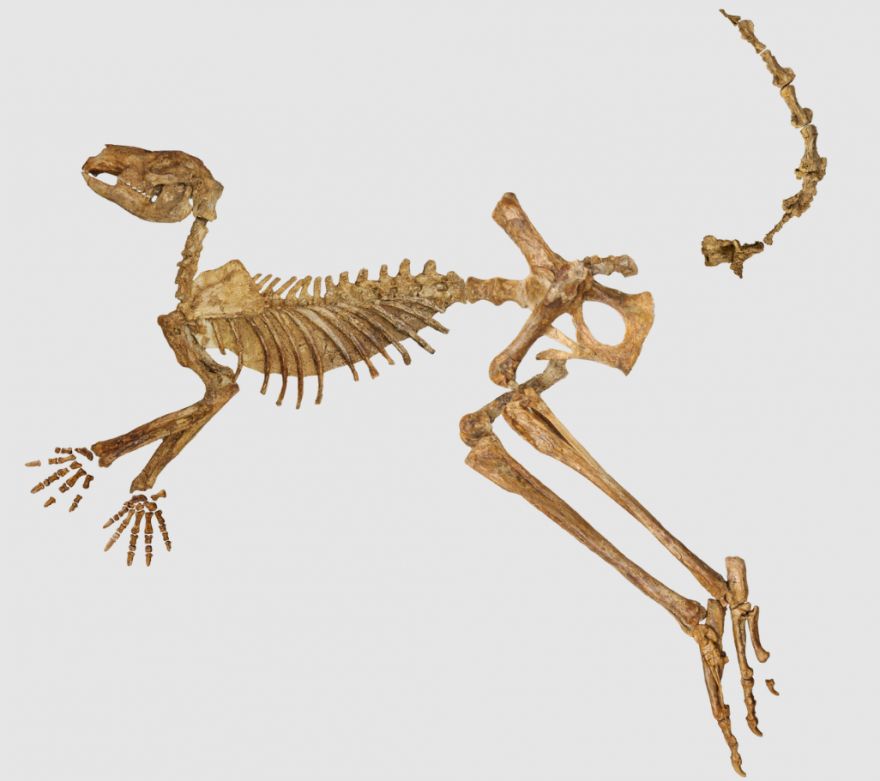
Kangaroos are quite feisty creatures. Generally, they don't attack humans but could become very aggressive when they feel threatened. Their kicks pack a very massive force which can severely injure adult humans and even be fatal. From a distance, they are adorable creatures, hopping around and minding their own business.
Now, that's just the kangaroos of today. The largest one is the red kangaroo, which when fully upright, can stand up to five feet, and weigh up to 200 pounds. But there are kangaroo species from way back that belong to the genus Protemnodon, which were giant behemoths in their own right.
Based on some of the fossils that Isaac Kerr, a kangaroo paleontologist at Flinders University, has found in the Lake Callabonna area, three new species of Protemnodon show that these marsupials may have been the largest of its kind.
The biggest of them, the Protemnodon viator, is estimated to have been about eight feet tall when standing straight. Even if it were just in a crouched position, P. viator would have stood at six feet. Not only that, but it grew to weigh around 375 pounds.
The other two species discovered were P. mamkurra and P. dawsonae. How these ancient kangaroos grew to be so large may be due to the fact that the Australian continent underwent a period of aridification. This might have pushed the kangaroos to adapt to its changing environment.
P. viator, especially would have been greatly impacted. Its name was derived from the Latin word for "traveler", which gives us an idea that P. viator had to cover wider distances in search for food, and so it had to undergo morphological changes that would enable it to have more stamina, more jumping power, and endure the harsh weather.
The reason why P. viator is speculated to have developed these feats is because of its broader distribution of fossils compared to P. mamkurra and P. dawsonae, which might have stayed in the woodlands.
Being able to study the lifestyle patterns and changes that these Protemnodon experienced may help us understand how climate change transforms behavior and ecology. In so doing, we may also be able to predict how climate change would impact the flora and fauna in the future.
For now, Kerr will continue to investigate the Lake Callabonna area in search of other marsupial fossils, with his next target being the largest marsupial to have ever lived, the Diprotodon optatum, the extinct giant wombat.
(Image credit: Isaac Kerr)
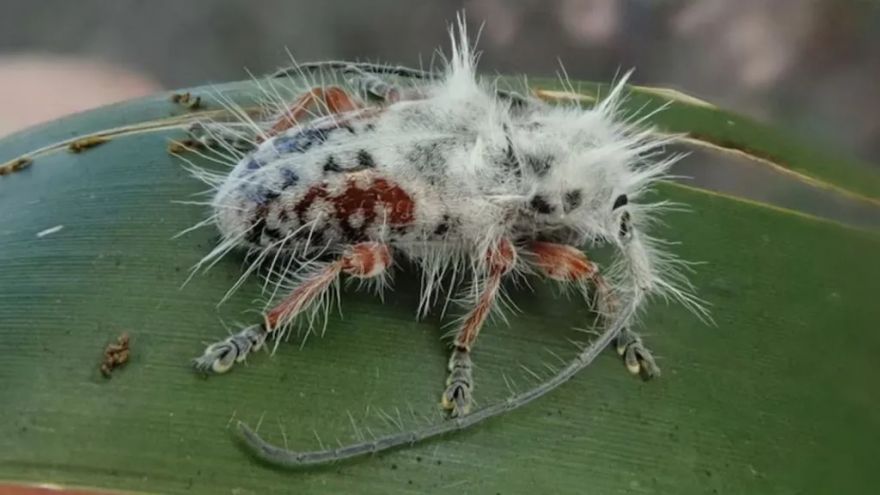
What are the chances that you will discover a new species of beetle while you're camping? It's a very rare opportunity, and fortunately for entomologist James Tweed, that opportunity fell on him like bird poo. Not literally, of course.
It happened while he was out camping in the Gold Coast hinterland in December 2021. Nobody would probably fault him for thinking that the new species of longhorn beetle was bird poo, since it was only one centimeter long and covered in fluffy white, spiky hairs all over its body.
He first saw it on a leaf, and thought nothing of it until he did a double take, and discovered that it was actually a beetle, the likes of which he had never seen before. Excited, he took a picture of it, and went around online to ask a Facebook group of insect enthusiasts to identify what beetle it is.
When nobody came up with an answer, he knew that he had discovered something new. Thankfully, he's a PhD candidate at the University of Queensland, so he took the beetle to the CSIRO's Australian National Insect Collection to be studied.
And true to Australia's identity as the land filled with some of the most exotic and dangerous creatures in the world, this new species of beetle goes on the list, along with spiky-haired caterpillars, and an orange-maned jet black ant.
The new beetle has been named Excastra albopilosa which means "white and hairy (albopilosa) in the camp (Excastra)." Scientists surmise that the beetle developed this trait of white hairy spikes as a defense mechanism against predators, as it mimics that of an insect killed by a fungus.
(Image credit: James Tweed)
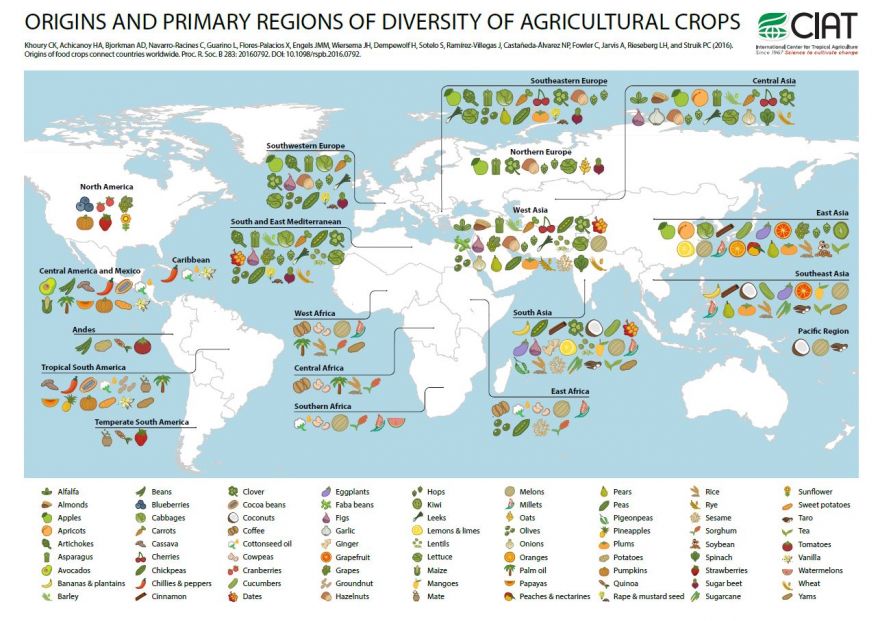
We have the early global explorers like Christopher Columbus to thank for the diversity of our crops today, and how we are able to grow these foodstuffs outside of their native lands. But to give us some context, a team of researchers have looked into the different origins of today's 151 staple food crops and plotted them on the map above.
Many of the crops listed overlap in different regions so, for example, wheat originally came from both Central and West Asia as well as the South and East Mediterranean. Apples, on the other hand, were grown natively in Europe, Central Asia, and East Asia.
There are also certain crops which are quite rare like tomatoes and potatoes, which, according to the map, were only native to the Andes. The same is true for watermelons, which were just grown in Southern Africa.
North America alone had sunflowers until some Spanish sailors discovered them in 1510 and brought boatloads back to Europe. Finally, Central America and Mexico brought corn to the rest of the world.
In terms of trade, according to the paper, most of the regions that have the least diversity of crops were the most dependent on foreign crops. That's why many European explorers had to venture out into the world to find these foodstuffs. North America and Australia are two other regions that need to introduce a lot of foreign crops, since they only have a limited range of native crops.
On the other hand, regions like Asia and Africa that have a higher crop diversity are less dependent on foreign crops. The highest growth of adoption of foreign crops include soy bean which is experiencing a boom in production in Brazil, and palm oil in Indonesia and Malaysia.
Research on crop origins, however, began almost 100 years ago with Nikolai Vavilov's centers of origin of cultivated plants. With the aim of improving crop yields to combat famines, Vavilov traveled around the world collecting food samples. He was able to amass 250,000 samples of seeds, roots, and fruits, and identified seven centers of origin.
Despite this, he drew the ire of Stalin and he was sentenced to death, which was later commuted to 20 years in prison. He died in prison in 1943, and many other scientists who were there with him, gave up their lives, dying of starvation, to protect the seeds that he collected. Later on, Vavilov was posthumously pardoned and received honors for his scientific contribution.
Agriculture and farming are truly one of the most game-changing innovations in history. Without it, civilizations might have struggled to build their societies and culture. Even today, with advances in genetics and bioengineering, we are making strides toward improving these crops.
(Image credit: International Center for Tropical Agriculture)
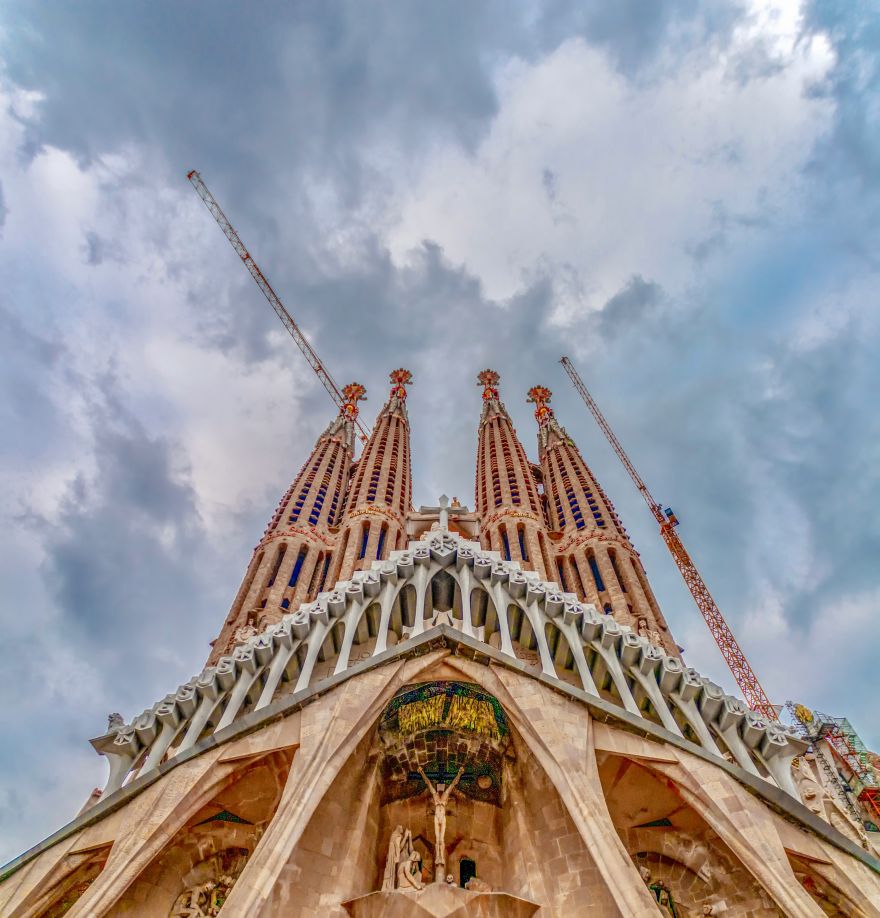
After almost a century and a half, the Sagrada Familia finally has a tentative completion date in 2026. Once finished, it will be the tallest building in Barcelona standing at 172.5 meters.
Although the main structure is expected to be completed in 2026, the rest of the furnishings including the sculptures, the stairway leading to the main entrance, and other decorative details will continue until 2034.
The idea to build a basilica of this magnitude came from the bookseller Jose Maria Bocabella, who, after returning from a visit to the Vatican, was inspired to build a church similar to the basilica at Loreto. Being the founder of Asociación Espiritual de Devotos de San José, Bocabella was able to arrange for the construction to be started in 1882, with help from donations.
Originally, the chief architect of Sagrada Familia was Francisco de Paula del Villar, but after he resigned, Antoni Gaudi replaced him and incorporated a lot of his architectural and engineering style which used a combination of Gothic and Art Nouveau.
After Gaudi died in 1926, work on the basilica continued, weathering several incidents including the Spanish Civil War in 1936, an arson case in 2011 which damaged the sacristy, and the COVID pandemic.
Also, the lack of financing has been a constant hindrance to construction. Donations used to be the source of funds for the project, but later on, with a stream of income flowing from tourism, it's able to generate around €125 million, half of which goes to the construction.
Currently, several works of Antoni Gaudi have been designated as UNESCO World Heritage Sites, although Sagrada Familia has not yet been included. The Nativity facade and Crypt of the basilica are two of the seven buildings built by Gaudi with this designation.
(Image credit: Zhiyuan Sun/Unsplash)

Sometimes, I imagine what I would do if I were to be shipwrecked on an island in the middle of the ocean. What steps do I take to ensure my survival? How long will it be before I get rescued? These questions are all hypothetical, for the most part.
At the very least, I think that being stranded on an island isn't as bad as simply floating on the ocean with no salvation in sight. I can swim for days on end without seeing land on the horizon. I could die of dehydration, or fall prey to the carnivores of the ocean.
So, the island is probably better. There's bound to be a source of food and water. And I can build a makeshift shelter. I can pass my days in that way until I spot an aircraft flying above, giving me hope that I might be rescued. Now, what would complicate this already scary hypothetical scenario is if the island were to be swallowed up by the ocean, a la city of Atlantis.
In fact, there is a small island off the coast of Sierra Leone that's gradually being submerged under water, bit by bit. That's the tropical island of Nyangai, where, back in 2013, about 500 homes had stood, but a decade later, fewer than 100 are left.
The photo above shows a comparison between an aerial shot taken by Google Earth of the island in 2011, and in 2023. Back then, it stretched to about 700 meters in length, but it has now shrunk to just 170. Where once there was a sprawling community who have been living on the island for generations, now they have slowly been forced out to start a new line on the mainland.
Climate change may have something to do with it. With more erratic weather and more storms, the sea level has been rising thus leaving less room for the people of Nyangai. Not to mention, the island itself is only about one or two meters above sea level, so a small shift in the ocean currents or the amount of precipitation each year can erode the island's land mass.
Why the people of Nyangai chose to stay on the island for so long, is mostly because of the tranquility of life on the island. Despite the lack of modern infrastructure, the islanders can live secure in the fact that there are no snakes or malaria on the island.
More than this, they were shielded from the problems that the mainlanders faced. The Ebola pandemic in 2014 barely touched the island, and they were relatively insulated from the effects of Sierra Leone's civil war in the 1990s. There's also the factor of familiarity of life on the island. It's the only home that they have ever known. And the sea is taking that away from them.
At the moment, there have been a few initiatives from the government to stem the tide. However, due to a lack of data and resources, it would take a much longer time to develop a plan to salvage the remaining patch of land left on the island than to simply evacuate the area, since the waters will most likely sink the island soon.
Other efforts done by the islanders themselves include planting mangroves, which failed since the seedlings died out before ever maturing, and bolstering their homes with sand, timber, and other sturdy objects.
Now, it's only a matter of time before Nyangai becomes completely submerged, and so the remaining islanders have all begun to prepare for the worst and are planning on moving to neighboring islands or the mainland.
(Image credit: Google Earth)

I'm not a fan of buying ebooks. To be perfectly honest, I will never get an ebook unless it's free or I don't have access to a physical copy of the book because it has limited copies. I would much rather spend my money on a secondhand book, which may have tattered edges, browning pages, or a creasing spine, than have a digital copy.
I only realized today how incredibly prevalent garbage ebooks are on Amazon. I have known about online publishers who mass-produce books on particular subjects filled with clichés, platitudes, and generalized information that I can find just by typing a question on Google's search bar. Basically, these are books made at low cost, and inundated with scraped keywords guaranteed to work effectively on Amazon's algorithm to get the books recommended on the first page.
This system is further aggravated and made even more efficient due to the emergence of AI tools. With it, anybody can write hundreds of pages for a manuscript within days or even within hours. That's how powerful the AI has become, but if you've actually read what AI writes, it's stale. Boring. No human touch whatsoever. It's as if you're reading a novel that's structured as an academic or scientific paper.
Now, don't get me wrong. The output that AI produces is actually passable, and that's why a lot of these garbage ebooks can sell. There are other factors that contribute to their popularity, however. One of which is based on something that had existed before AI even came into the scene: review swapping.
If anybody wants to have more people buy their books, then one of the best ways to game Amazon's system is by hijacking the reviews. That is, if you can pay people to publish five-star reviews on your book, then, Amazon's algorithm will more likely recommend your book to others or put it on their first page.
Before, if these ebook publishers wanted to make a quick buck, they simply search the most popular keywords, and have an army of ghostwriters writing manuscripts for them. Once they are published, they have another group of review swappers who would exchange five-star ratings with each other. And they can just sit back, and watch the stream of passive income flow into their pockets.
This is one of the reasons why Amazon had to tighten their regulations on their publishing arm. They banned some accounts that were violating their guidelines on content, and they placed a limit on the number of ebooks an account can publish.
Still, the grifters have already dug their roots and have expanded their base on this pyramid. If you want to read the more detailed account of how these started, Vox's article goes into a succinct but informative story on Big Luca and the Mikkelsens.
But the point is this. Amazon's system has incentivized this kind of shady practice to run rampant on their platform because they prioritize lower costs with higher volumes, which helps in maximizing their profits, to the detriment of the poor consumers.
Unless you're someone who does an initial research on the books that you want to buy, and scrupulously checks the authenticity of reviews on Amazon, and perhaps even go so far as make comparisons between the retailers, then you might just get swallowed up by the system, and find yourself purchasing an incredibly trashy ebook for $0.99.
(Image credit: freestocks/Unsplash)

I recently read an anecdote from a child of a former POW during WWII. He recounted how his father had spent three and a half years in the Philippines as a POW under the Japanese. After the war, his father returned to the US and became successful in the insurance business.
From time to time, during his childhood, he recalled how his father would wake up suddenly in the middle of the night in fits of screaming and panic, which would wake the whole house, until his mother would finally calm his father down. No doubt the memories from the traumatic experience his father lived through have become embedded in the psyche, and occasionally haunt him in his nightmares.
I have never personally witnessed someone go through those episodes of PTSD, being generations apart from that era. My grandmother would tell me stories about that period, but she never experienced the abject horrors of the war like those who were on the front lines, so I can hardly imagine what it's like living with those memories.
There have been studies conducted on how to reduce the adverse effects of traumatic experiences. One such study examined whether playing Tetris, a visuospatial video game, could help alleviate the symptoms of PTSD. The idea is that playing Tetris would overload and distract the brain from forming the memories of the traumatic experiences. And in so doing, there will be fewer recurrences of those visual memories thus fewer interruptions in a person's daily life.
The first study was conducted in 2009, but within a controlled environment under the supervision of professionals. Participants were shown footage of traumatic events, and about 10 to 40 minutes after, they were instructed to play Tetris. The researchers measured how many intrusions the participants experienced throughout the week.
The results showed that there was a reduction of the number of intrusions but whether these would translate to people who have gone through actual traumatic events in their lives was yet to be determined.
Several clinical studies attempted to use this method on women experiencing birth trauma, people who were involved in vehicular accidents, as well as war refugees and war veterans. These studies did show that there was also a reduction of the number of intrusions, but the scale of the studies is still too small to be considered significant and conclusive.
Of course, every bit helps. Even if playing Tetris will not wipe away all the traumatic memories, it is a good way of distracting people. In fact, any other visuospatial game can possibly be used. But still, people with PTSD require professional help. Therapy, along with other rehabilitative programs, can help people process the trauma and pain that they went through, as well as having a good support system in their family and community.
(Image credit: Ravi Palwe/Unsplash)
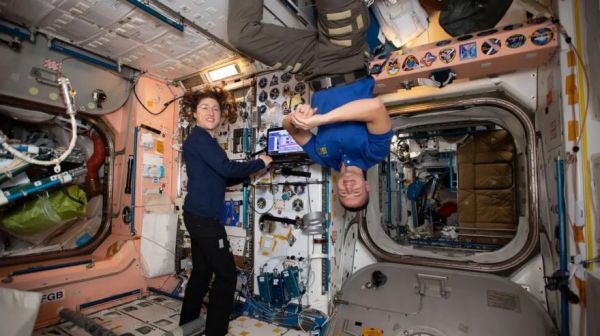
The International Space Station was launched 25 years ago and has hosted nearly 300 astronauts from around the world. Each of those astronauts carries their own natural biome into space. There have been many experiments on the effects of space on bacteria, which show the effects of microgravity, radiation, air quality, and other conditions on their rate of mutation. But there are also bacteria that just go along for the ride, and a sampling of those bacteria show evidence of mutation as well. A survey of environmental bacteria on the ISS was conducted in 2019, and further research was done on 13 strains of Enterobacter bugandensis, which can cause gastrointestinal infections.
They say what doesn't kill you only makes you stronger, and that has proven to be the case for this bacteria. Scientists found that the E. bugandensis on the space station has mutated to be more resistant to antimicrobial treatment. We don't know what danger this may pose to astronauts, or the people they come home to after their mission. Read more about this discovery at Gizmodo. -via Fark
(Image credit:NASA)




